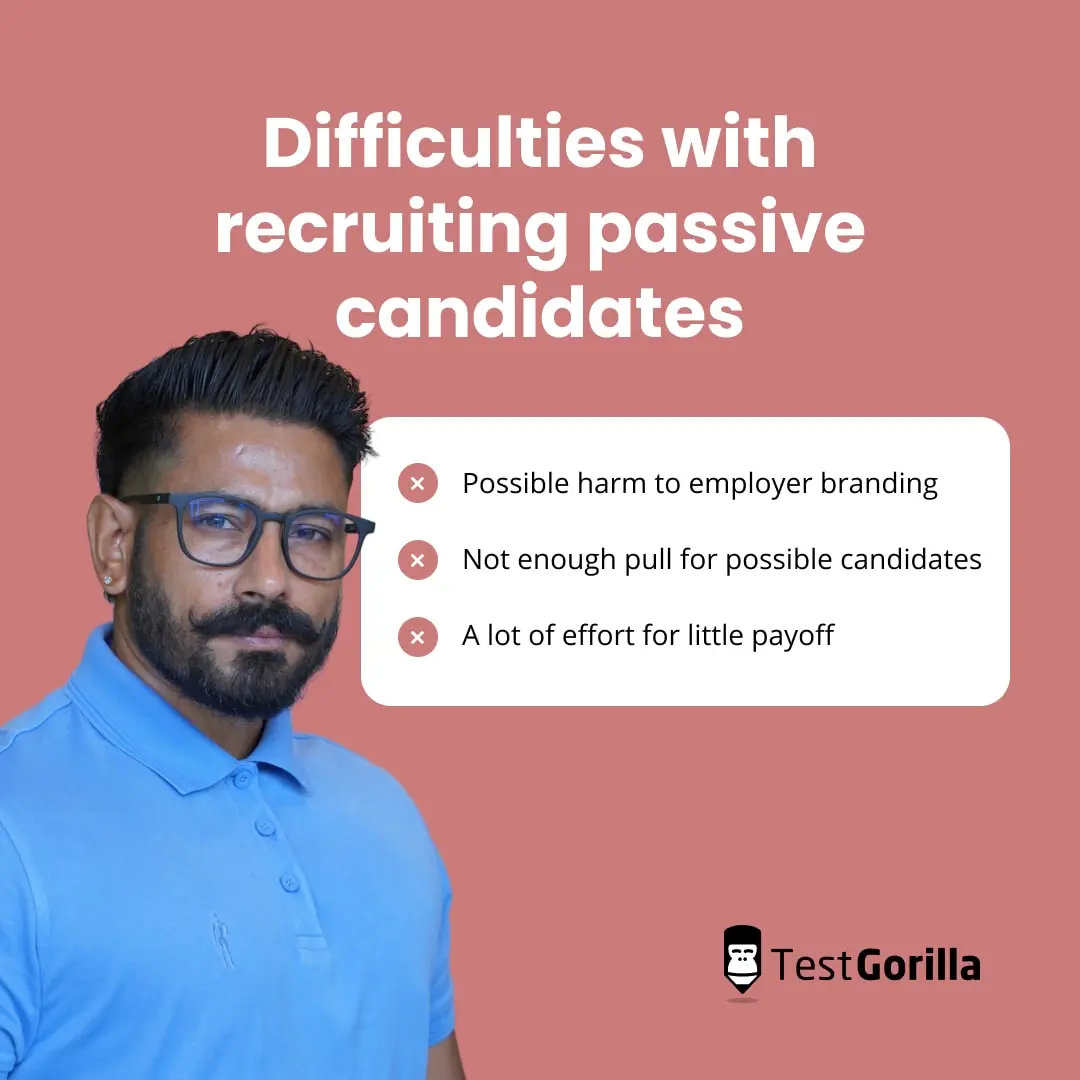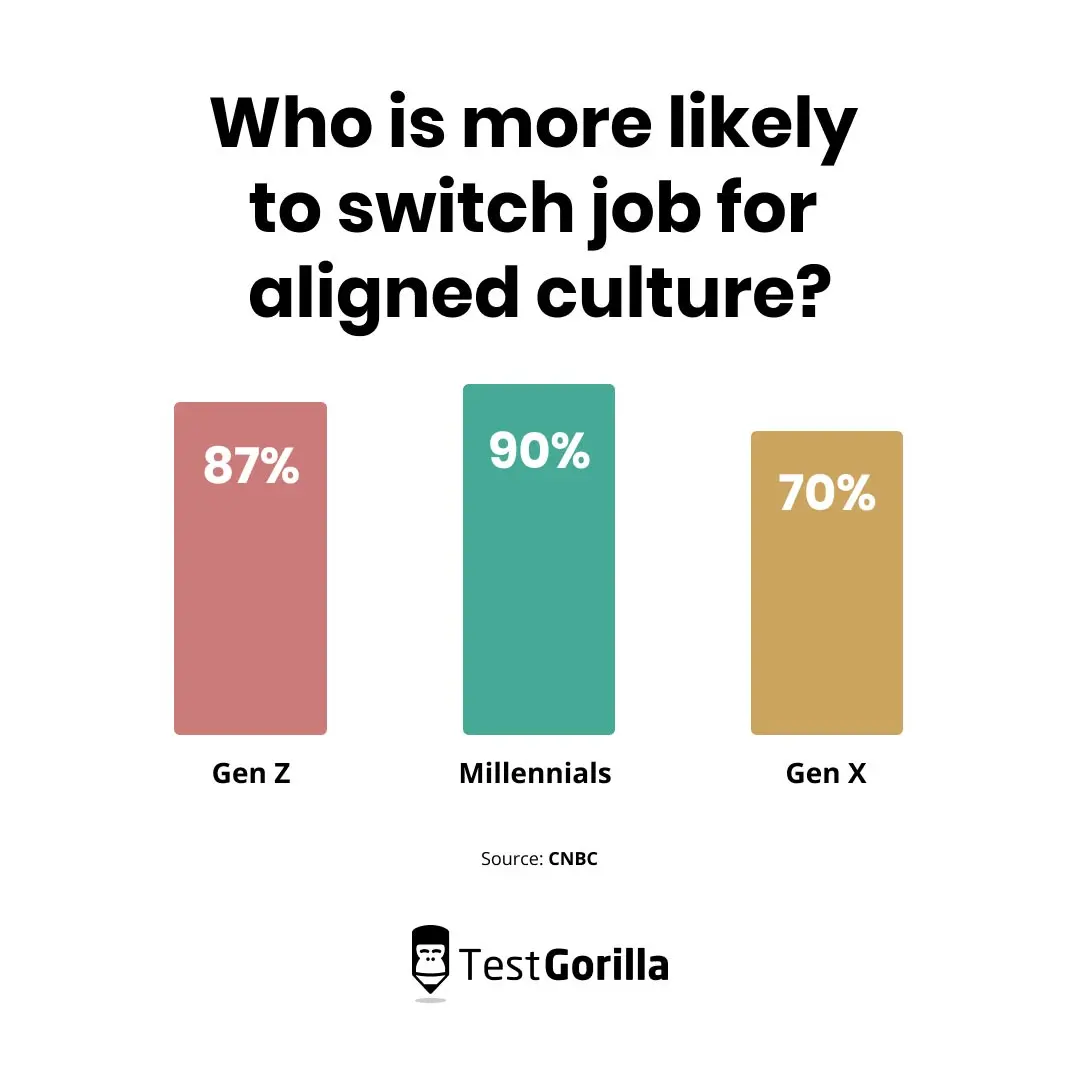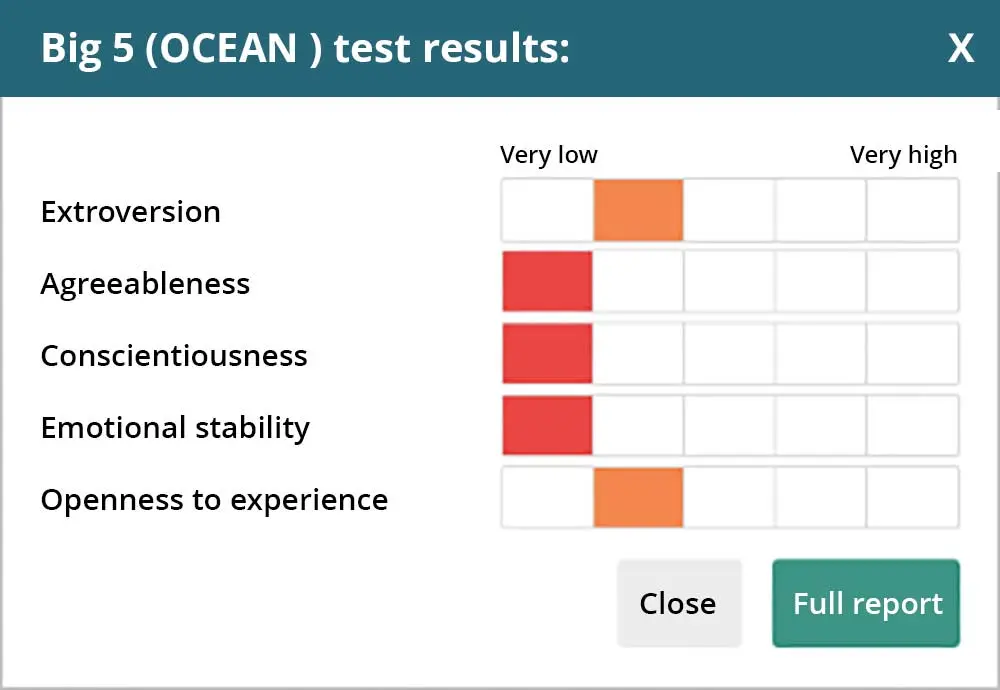Recruiting passive candidates is a big deal to most hiring managers.
They check every recruiter tickbox because they remove some of the biggest hiring hurdles.
These candidates are usually highly skilled, unlikely to misrepresent their abilities, and not being pursued by competition.
But there’s a catch – passive job seekers aren’t looking for a new job, which means your company needs to stand out to convince them to join you.
A tall order, but it shouldn’t be an issue when your organization uses talent assessments for hiring, training, and development.
When you use talent assessments in your company, it not only helps you verify skills and culture, but it also boosts your employer brand and makes your business an attractive place to work.
This blog discusses the top challenges when recruiting passive candidates and the nine ways that skills tests make the process easier.
Table of contents
What are passive job seekers?
Passive job seekers are job candidates not looking for a new role. Because they aren’t job hunting, they require careful consideration, nurturing, and patience to recruit them.
Recruiting passive candidates isn’t impossible – just because they aren’t actively looking for a new role doesn’t mean they aren’t open to new opportunities.
So, what’s the specific difference between passive candidates vs. active job seekers?
Active candidates are searching for open positions and are ready to leave their current employer if they have one. They’re reading job postings, filling out applications and resumes, researching companies, and preparing to adopt a new role. Passive candidates aren’t.
Recruiting passive candidates isn’t all just “convincing them to leave their jobs.” Many hiring strategies involve nurturing passive job seekers so when they’re naturally ready to turn active, you’re also ready for them.
How to source passive candidates
When it comes to passive candidates, candidate recruiting is less straightforward than with active candidates.
Instead of posting job descriptions and sorting through applications, you’ve got to go out there and find candidates who aren’t quite ready to apply.
Here are a few effective sourcing techniques for passive candidates:
Methods | Description |
Use social media | Search social media for hashtags relevant to your company. Look for people who have insightful, helpful posts or provide great comments on other people’s posts. |
Use sourcing tools | Try candidate sourcing software to scour databases and find likely candidates. You can use AI in talent acquisition. |
Meet candidates through employees | Ask current employees if they know any talented professionals. Having a connection helps you gain solid ground (more on this later). |
Find them through past hiring initiatives | Look through your database from previous hiring efforts. You could find a few “silver medalists” worth pursuing. |
If you’d like to learn more, read about the topic in-depth in our post on passive recruiting.
The difficulties with recruiting passive candidates
The application process for passive candidates isn’t the only speed bump you can encounter in your journey to creating a talent pipeline.
You must be mindful of certain challenges to secure this top talent.
Possible harm to employer branding
If you don’t take due consideration, targeting passive job seekers could harm your employer branding.
For example, a candidate could get irritated by a hiring manager who:
Messages them too much on social media
Snubs the candidate’s current company
Tries to “hard sell” their organization with unrealistic incentives
This approach damages the relationship with the current candidate, but it’s more harmful than that. It could snowball into something greater if the candidate spreads the word on social media platforms.
Candidates could start to see your company as pushy or disrespectful if you’re too forceful, so it’s important to be careful and courteous.
Not enough pull for possible candidates
It takes a certain something to convince passive job seekers to switch, and many companies on the job market don’t have it – or they do have it, but they aren’t displaying it right.
The best candidates want specific qualities in a prospective company:
A good company culture and a work-life balance
Great employer branding, such as a great candidate experience and fair hiring practices
The last point is important because 48% of workers would leave their current job if the new employer provided learning opportunities.
Potential candidates have high expectations, especially those with niche skills in high demand, which is a common trait of passive job seekers.
Many of these workers are likely to tell you “no,” no matter how courteous you are if your business doesn’t have the job opportunities they need.
A lot of effort for little payoff
A lot of work goes into persuading passive candidates, and if they don’t have the right skills or aren’t a good culture add, it could be wasted time.
Another concern is the dreaded question: “What if they tell your firm ‘no’ after all that time spent attracting them?”
We have ways to mitigate both these risks by assessing the candidate’s skills and increasing the attractiveness of your company and job opening.
Let’s explore those next.
How talent assessments help hire passive candidates
You can mitigate these challenges by committing to skills-based practices and assessing passive candidates with skills tests.
Here are the four top ways talent assessments help you hire qualified candidates.
Promote employer branding
The most important aspects of employer branding are values, beliefs, and company culture.
Candidates don’t just appreciate an employer committed to their values. They expect commitment.
One study found that 87% of Gen Z professionals would quit their jobs to work elsewhere if the new company’s values and their own values align more closely.
Nine in 10 Millennials and seven in 10 Gen Xers felt the same.
This data means that culture is crucial when hiring Gen Z workers and an equally important point to consider when hiring millennials.
This study also found that 60% of Gen Zers and Millennials said that company values are a job dealbreaker, and 59% of European professionals would not work for a company if its values didn’t align with their own.
Some important modern values include fair hiring, a commitment to diversity, and dedicated learning and development.
Talent assessments help you adopt and display these values for everyone to see. Candidates want you to show them your values, not just tell them about them.
Boost the candidate experience
The candidate experience makes your company more attractive and is another part of your employer branding.
It is an important strategy for recruiting passive candidates.
TestGorilla’s State of Skills-Based Hiring 2022 report found that 54.3% of candidates prefer a hiring process with talent assessments.
Here are a few reasons why:
Accuracy and transparency
Inclusivity and equality
Ease of career switching
Talent assessments reduce anxiety, level the playing field, and gauge people on their skills, not their education or connections.
Read our blog on skills-based hiring from a candidate’s perspective for more information on why workers love skills tests.
Reduce mis-hires
Talent assessments objectively assess skills and reduce mis-hires through real, data-driven processes. Companies that used skills-based hiring in 2022 saw a 92.5% reduction in mis-hires.
Assessing talent determines how qualified your passive job seekers are, whether you’re assessing candidates who just turned from passive to active or scrolling through your database of “silver medalists.”
These evaluations enable you to quickly ascertain if they have the right skills.
You’ve already spent a long time sourcing and nurturing them, so you don’t need to hire them and spend a few weeks discovering they’re a bad hire.
Shorter time-to-hire
Talent assessments increase hiring efficiency considerably. Our data shows that 91.4% of organizations that used skills-based hiring reduced their time-to-hire.
A fast hiring process is always attractive, but it also helps recruit passive candidates in two major ways:
You spend a lot of time sourcing passive candidates, so you can speed up the later parts of hiring with skills tests
When a passive candidate turns active, you can act faster than the competition by using skills tests
You already have a leg up on the competition when recruiting passive candidates if you spend time nurturing them. Talent assessments enable you to fly through the process before the competition knows they’re active.
9 ways to use talent assessments to optimize recruiting passive candidates
Learning how to recruit passive candidates isn’t difficult when you leverage talent assessments, and it’s worth the effort.
Let’s look at the top ways to use skills tests to help you successfully hire passive candidates.
Ways to use skills tests for passive candidates: A summary
Strategies | Description |
1. Determine your goals with a skills gap analysis | - Assess your current workforce to ascertain which skills you’re lacking - Use this information to begin sourcing passive candidates |
2. Strengthen your employer brand by switching to skills-based hiring | - Tell passive candidates about your commitment to fair hiring - Show candidates your values by using skills tests in the hiring process |
3. Improve the candidate experience with talent assessments | - Improve transparency in the hiring process - Focus on skills instead of certifications to improve candidate confidence |
4. Improve wellbeing with skills-based practices | - Match candidates to their roles to boost wellbeing and promote satisfaction - Talent assessments help create an atmosphere of inclusivity and assurance |
5. Ensure they have the right skills and personality | - Evaluate skills to reduce the chance of mis-hires - Gauge hard-to-assess soft skills |
6. Act fast and hire passive candidates quickly when they become active | - Reduce time spent on tedious tasks by using skills tests - Focus on the important tasks to speed up hiring |
7. Leverage employee referrals | Encourage employees to make social media posts and tell other professionals about their positive experiences in a skills-based company |
8. Offer learning and development opportunities | - Use talent assessments to build a development program - Use skills tests throughout the process, such as gauging beginning skills and verifying skills after training |
9. Find great passive candidates through past “silver medalists” | - Use talent assessments to store prequalified candidates - Search through past initiatives to find candidates who already know about your organization |
1. Determine your goals with a skills gap analysis
Use talent assessments to find skills gaps in your company and determine your hiring needs before you begin your search.
Sourcing passive candidates is faster, easier, and more effective when you know exactly what you need.
A skills gap analysis shows you what skills you have in your workforce and what you’re lacking, so you can hire accordingly. When you use talent assessments, the process becomes highly accurate and data-driven.
Here’s a quick rundown of a skills gap analysis:
Identify primary business goals
Determine short- and long-term objectives
Identify the skills you need to achieve these outcomes
Conduct individual and team-based skills gap analyses using talent assessments
Create a plan to address any gaps
This analysis gives you specific information on the skills and competencies you need, rather than just making guesses or relying on gut instinct.
For our full guide on the subject, check out our article on conducting a skills gap analysis.
2. Strengthen your employer brand by switching to skills-based hiring
Candidates want a company with strong, forward-thinking values, but they don’t know it until you show it.
Adopt skills-based hiring, use skills tests, and shout it loudly and proudly.
Having a firm stance on equal hiring is an important value to passive job seekers, but they only know about it when you:
Wear your values on your sleeve: Use recruitment marketing to talk about your commitment to skills-based hiring on social media and in newsletters
Show, don’t tell: Actions speak louder than words, so actively use fair hiring methods. Use talent assessments, conduct structured interviews, and toss away the resume.
Using talent assessments is the most powerful way to show your dedication to skills-based hiring, but candidates may not make it to the application stage if you don’t tell them first.
Don’t make candidates dig for your stance on important matters like fair hiring. Proudly show your commitment to equal practices and diversity in places they can see it, like your careers page or “about us” page.
Once they know your values, they can see them in action when they hit “apply.”
For an in-depth guide on this topic, read our blog on employer branding.
3. Improve the candidate experience with talent assessments
Candidates need a great experience with your company to spread positive messages about it. Passive job seekers look for those messages as a green flag to working with you.
Talent assessments improve candidate experience in many powerful ways:
Assure applicants that you evaluate them fairly
Reduce candidate anxiety
Give increased transparency into the process
Reduce time-to-hire, making it more considerate of their time
Enable them to try new career paths without a certain amount of years of experience or college degrees
Stellar candidates with skills from alternative sources, such as candidates skilled through alternative routes (STARs), shouldn’t be denied great careers because of their educational history.
Millions of candidates feel a boost of confidence when they see college degrees aren’t required.
Whether or not you’re recruiting passive candidates with college degrees, mentioning this point matters.
Even candidates with extensive educational backgrounds feel positive about a hiring process that doesn’t have strict requirements.
4. Ensure they have the right skills and personality
Use talent assessments to evaluate candidates’ skills and culture to ensure they are a great addition to your company.
You’ve already spent a long time nurturing this relationship. If your passive candidates turn into bad hires, that’s even more time wasted.
Skills tests help you reduce time spent and mis-hires by gauging candidates’ technical skills, language proficiency, soft skills, personality, and culture add.
Those last three points are crucial. Research shows that personality, soft skills, and attitude cause 89% of hiring failures. These three factors don’t stand out in a resume.
Here’s what it looks like to gauge personality with TestGorilla:
After a candidate finishes their assessment, you review detailed results showing factors like agreeableness and emotional stability.
Traditional hiring methods can’t measure crucial success criteria like this. For example, you could nurture a passive candidate for months, hire them because of their stellar resume, and then end up with a low-quality hire.
Read our five stories from resume recruiting hell for more insights, if you’re brave enough.
5. Act fast and hire passive candidates quickly when they become active
Talent assessments drastically reduce time-to-hire, so when a passive candidate becomes active, you can react faster than the competition.
Skills tests are recruiting automation software, which means they help you automate your tasks and speed up the process.
Revolut, a British-Lithuanian bank, used skills tests to reduce its time-to-hire by 40%. Hydroemission, an environmental technology company, also used skills tests to reduce its time-to-hire by at least 80%.
Talent assessments enable you to automate the tedious parts of the recruitment process, like shortlisting and rejecting candidates.
For example, Revolut used them to gauge language proficiency, which usually takes time and effort and is also subject to human error.
This way, you hire passive job seekers faster and have more time to nurture future passive candidates.
6. Leverage employee referrals
Using employee referrals to attract the best talent boosts your hiring strategy in two big ways. It increases your employer branding and helps collect passive job seekers.
Encourage your employees to post about their positive experiences in your skills-based company and create outreach online.
They naturally spread the word about your organization and subtly tell their connections that joining your company is a good idea.
Here are a few great things for your employees to mention:
Being hired via skills tests
Being upskilled with skills tests
Nothing’s quite as powerful as seeing an employee making great claims about a business. Reading about the power of skills-based hiring adds more depth to it.
Read our blog about creating an employee referral program for more insights on adopting this talent acquisition strategy.
7. Improve wellbeing with skills-based practices
Skills-based practices improve employee wellbeing, which is one of the main reasons passive candidates make the switch.
Workers want a company that cares about their wellbeing, and they join new organizations to get it.
Gallup research found that employees of all generations rank how much an organization cares about employees' wellbeing in their top three criteria for an ideal employer.
Iseult Morgan, a management consultant at Gallup, says:
“Many talented workers are leaving for workplaces that align with their personal belief system and show an authentic concern for individual employee wellbeing.”
Talent assessments improve employee wellbeing in meaningful ways:
Matching candidate skills to roles, making employees better and more confident about performing their jobs
Creating an inclusive atmosphere where you gauge people by their skills and performance, not their education and connections
A skills-first organization fosters a healthy environment where you recognize employees for what they can do, not who they are personally.
For more insights, read our article on skills-based hiring and employee wellbeing.
8. Offer attractive learning and development opportunities
Regardless of position, every worker wants career development, and increasingly more candidates don’t just want it from a company.
Instead, they expect to read about it in the job descriptions on job boards and LinkedIn.
Talent assessments make building effective development programs and leadership development plans for your people quick and easy.
Similar to conducting a skills gap analysis, the process looks like this:
Use skills tests to assess employee skill levels
Review the results and see who’s ready for upskilling
During training, use skills tests to monitor growth and development
Regularly use talent assessments to verify and validate employee skills so you know when they’re ready for their new role
Development opportunities give candidates and employees what they want and ensure they’re ready for their responsibilities, which helps mitigate risks.
Building an employee training and development program benefits your whole workforce. It can be the tipping factor for passive job seekers on the edge of making decisions.
9. Find great passive candidates through past “silver medalists”
When you use talent assessments for hiring initiatives, all of your unsuccessful candidates get stored in a large database filled with likely future candidates.
After a hiring initiative, use your database of previously unsuccessful candidates to get a head start on a few important points when sourcing passive candidates.
First of all, these candidates have already proven their skills and personality. Maybe you didn’t initially choose them because the interview process offered you many quality candidates.
You can upskill them with your new development program, even if they lack a few skills.
Another benefit of using these “silver medalists” is that they already know about your company.
Sometimes, breaking the ice is the toughest part of learning how to recruit passive candidates, and these people have already shown their interest.
This benefit is also present when rehiring former employees, who make great passive candidates.
Use skills tests when recruiting passive candidates to improve your efforts
A recruitment strategy for passive candidates is an excellent part of your hiring strategy, and when done right, it can produce amazing results.
Talent assessments help optimize this process by improving the candidate experience, boosting your employer branding, and giving you a database of likely future candidates to look through.
For more on this topic, read our blog on talent pool management to learn the best practices for managing your candidate database.
To assess passive candidates in crucial personality traits, such as openness and conscientiousness, look at our Big 5 (OCEAN) test.
Related posts
Hire the best candidates with TestGorilla
Create pre-employment assessments in minutes to screen candidates, save time, and hire the best talent.
Latest posts
The best advice in pre-employment testing, in your inbox.
No spam. Unsubscribe at any time.

Hire the best. No bias. No stress.
Our screening tests identify the best candidates and make your hiring decisions faster, easier, and bias-free.
Free resources
This checklist covers key features you should look for when choosing a skills testing platform
This resource will help you develop an onboarding checklist for new hires.
How to assess your candidates' attention to detail.
Learn how to get human resources certified through HRCI or SHRM.
Learn how you can improve the level of talent at your company.
Learn how CapitalT reduced hiring bias with online skills assessments.
Learn how to make the resume process more efficient and more effective.
Improve your hiring strategy with these 7 critical recruitment metrics.
Learn how Sukhi decreased time spent reviewing resumes by 83%!
Hire more efficiently with these hacks that 99% of recruiters aren't using.
Make a business case for diversity and inclusion initiatives with this data.




















